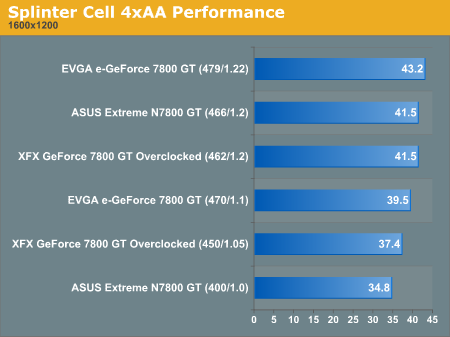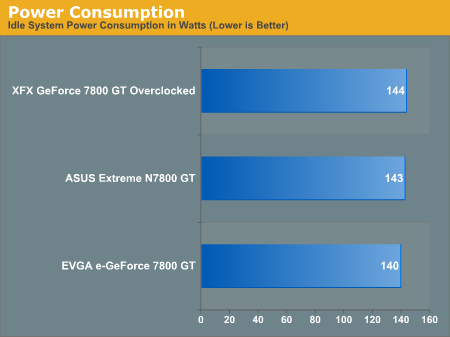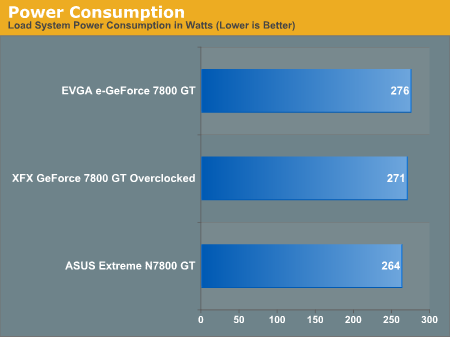Overclocking/Power Load
We've overclocked a few 7800 GTs in the past, with positive results, and we put each of these three cards to the test for this review. It is important for us to note here that overclocking any graphics card over the factory clock can be hazardous to the card, and also, the results of these tests are subjective. Many times, two cards of the exact same brand and model will have different results when overclocking, but these tests are to give us a general idea of each card's overclocking abilities.
Something that we want to touch on briefly is the issue of scaling frequencies for the 7800, which we first saw when overclocking the 7800 GTX. To recap, because of the way clock frequencies scale for the 7800 GT and GTX, increases in core clock speeds don't always represent actual increases in performance. There are "plateaus" where several consecutive clock speeds (i.e. 468, 469, 470MHz) yield nearly exactly the same performance, and then we see a sudden step up in performance between certain frequencies (i.e. 477MHz, 478MHz ) to create a "stair-like" graph when visualizing the performance scaling. You can take a look at a similar graph and some information about this from a past article here.
To give you an idea of how we overclock our cards beyond their factory speeds, we first use coolbits to detect optimal settings for each card. Then we loop some benchmarks, and lower the clock speeds if we see any graphical tearing or artifacts. A good thing about NVIDIA's overclocking tool is that it will keep the card fairly safe from damage caused by attempting to overclock it too high. We simply use trial and error, raising or lowering the core and memory clock speeds until we find settings that offer the maximum performance while running the tests completely stable.
When we overclocked the ASUS EN7800 GT, which is clocked at reference speeds (400MHz/1.0GHz), we find that it clocks up to 468MHz core and 1.2GHz memory. The XFX 7800 GT OC overclocked to 462MHz and 1.2GHz, not much higher than its own factory overclock. The EVGA e-GeForce 7800 GT had a fairly high overclock, considering that it already came factory OC'ed pretty high: 479MHz core and 1.22GHz memory clock. We ran some Splinter Cell benchmarks to see what kind of framerates would result at the different clock speeds, and here they are for your reference.
To test the power load of the card, we measure the total watt usage of our test computer at the wall outlet, recording the power usage of our system in two different states. The first state is with the card installed and the computer is idle, and the second is during intensive performance tests (looped Splinter Cell benchmarks). This way, we are able to get a general idea of how the power usage varies between cards.
We've overclocked a few 7800 GTs in the past, with positive results, and we put each of these three cards to the test for this review. It is important for us to note here that overclocking any graphics card over the factory clock can be hazardous to the card, and also, the results of these tests are subjective. Many times, two cards of the exact same brand and model will have different results when overclocking, but these tests are to give us a general idea of each card's overclocking abilities.
Something that we want to touch on briefly is the issue of scaling frequencies for the 7800, which we first saw when overclocking the 7800 GTX. To recap, because of the way clock frequencies scale for the 7800 GT and GTX, increases in core clock speeds don't always represent actual increases in performance. There are "plateaus" where several consecutive clock speeds (i.e. 468, 469, 470MHz) yield nearly exactly the same performance, and then we see a sudden step up in performance between certain frequencies (i.e. 477MHz, 478MHz ) to create a "stair-like" graph when visualizing the performance scaling. You can take a look at a similar graph and some information about this from a past article here.
To give you an idea of how we overclock our cards beyond their factory speeds, we first use coolbits to detect optimal settings for each card. Then we loop some benchmarks, and lower the clock speeds if we see any graphical tearing or artifacts. A good thing about NVIDIA's overclocking tool is that it will keep the card fairly safe from damage caused by attempting to overclock it too high. We simply use trial and error, raising or lowering the core and memory clock speeds until we find settings that offer the maximum performance while running the tests completely stable.
When we overclocked the ASUS EN7800 GT, which is clocked at reference speeds (400MHz/1.0GHz), we find that it clocks up to 468MHz core and 1.2GHz memory. The XFX 7800 GT OC overclocked to 462MHz and 1.2GHz, not much higher than its own factory overclock. The EVGA e-GeForce 7800 GT had a fairly high overclock, considering that it already came factory OC'ed pretty high: 479MHz core and 1.22GHz memory clock. We ran some Splinter Cell benchmarks to see what kind of framerates would result at the different clock speeds, and here they are for your reference.


To test the power load of the card, we measure the total watt usage of our test computer at the wall outlet, recording the power usage of our system in two different states. The first state is with the card installed and the computer is idle, and the second is during intensive performance tests (looped Splinter Cell benchmarks). This way, we are able to get a general idea of how the power usage varies between cards.












33 Comments
View All Comments
ElFenix - Thursday, December 8, 2005 - link
i would like to know the volume and character of the fan noise as well please.Night201 - Thursday, December 8, 2005 - link
I have the XFX 7800 GT. I took this one over the other because it came with an additional game - Call of Duty 2 (free after you submit a rebate form - took only about 2 weeks!)It's the full DVD version and that right there saved me $50 - so the total cost of the card to me (since I was planning on getting COD2 anyway) was about $275!
Can't beat that (at this time at least)!
Visual - Thursday, December 8, 2005 - link
a roundup of cards that are virtually identical... oh how interesting.well. they aren't really identical. but i'd appreciate an article that shows me the differences more clearly, focuses on the differences. like which cards are using the stock cooler and which use custom ones, what are the memory ratings for the various brands etc... even what games/extras are included in each brand's package. a single good comparison table can speak much more than your numerous benchmarks. after all, benchmark results are just proportionate to the clock/mem speeds... the way you structured this roundup, i have to hunt around it for the real differences among these cards.
bob661 - Thursday, December 8, 2005 - link
I think this would be a good idea.ashegam - Thursday, December 8, 2005 - link
why isn't newegg showing on the Anandtech price finder? the e-vga can be had for $309 and that's before a $20.00 rebate which drops it to $289. So add newegg to your price engine thingy :)KristopherKubicki - Thursday, December 8, 2005 - link
You mean this one right?http://labs.anandtech.com/search.php?q=evga%207800...">http://labs.anandtech.com/search.php?q=evga%207800...
Kristopher
deathwalker - Thursday, December 8, 2005 - link
It is fully understandable that the EVGA and XFX cards get the nod in this test. I would be willing to bet that some owners of these cards will be frequent visitors to the AT forums complaining about "graphics" problems(artifacts/ripping tearing). Both of these cards come from the factory apparently OC so close to the max line the it is inconcievable that they are all going to behave themselves in the real world environment once volume numbers of these cards are in the hands of the buying public. You can bet that not every card that goes out the door at these clock speeds has been thoughly burned in to confirm they can actually run at these speeds for an "extended" duration of time. There are bound to be chipsets and memory modules in finished products that will not perform well at those clock speeds for extended periods. Perhaps the saving grace here though is that you can always lower the clock speeds back towards the referance points and probably fix the issues that "may" occur.deathwalker - Thursday, December 8, 2005 - link
Interesting that Newegg sells a version of this card that is clocked at 445/1070.Leper Messiah - Thursday, December 8, 2005 - link
Perhaps but stastically, the portion of cards sold vs. cards that have problems will be small (hopefully) and with their lifetime warranties, you can always send it back, ableit at the cost of your own shipping. C'est la vie I suppose. But I think christmas time is going to be bringing me a XFX 7800GT and some kind of NF4 mobo. :)deathwalker - Thursday, December 8, 2005 - link
Santa is going to be kind to you...have you been a "good" boy?